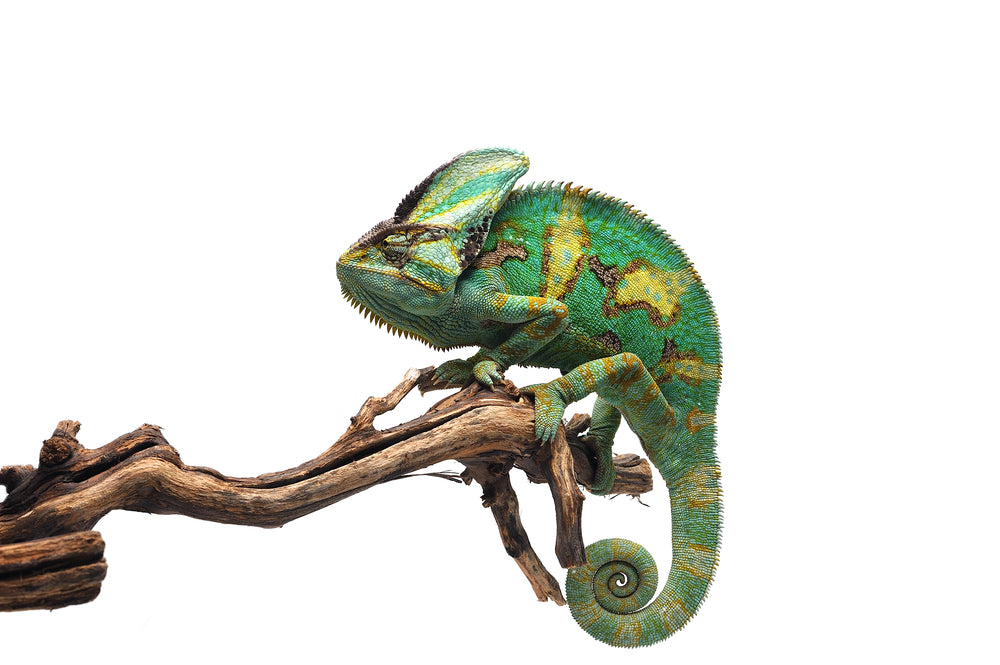Veiled Chameleon Caresheet

Veiled Chameleon (Chamaeleo calyptratus)
Difficulty: Hard
Veiled chameleons are large, arboreal lizards native to Yemen and southern Saudi Arabia, where they can be found in the subtropical to tropical habitats near the mountains. Since veiled chameleons are arboreal, they are most often found in trees or large shrubs, very rarely coming down to the ground. Unfortunately, from keepers releasing them outside they can also be found in Southern Florida.
Like other chameleons, veiled chameleons are diurnal, which means that they are most active during the day. As insectivores, they use much of this time for search for insects to eat.
Veiled chameleons can grow up to 22” long, but lifespan depends on gender. Males can live up to 8 years with good care, but females typically live fewer than 6 years.
Veiled chameleons make beautiful, fascinating pets, but keep in mind that it takes particular care and specialized equipment to help them thrive in captivity.
What You Need for a Bioactive Veiled Chameleon Enclosure
- 24" x 24" x 48" Mesh Screen Enclosure
- Small fan
- Exo Terra Reptile Deep Dome Fixture Small, x2
- Zoo Med Basking Spot Lamp 50w, x2
- plug-in lamp dimmers, x2
- Arcadia Forest D3 6% UVB T5 Bulb 22"
- The Bio Dude Solar Grow T5 HO Single Bulb Light Strip 24" (for UVB)
- The Bio Dude Glow & Grow 22” LED
- Temperature gun
- The Bio Dude Digital Thermometer / Hygrometer
- Zilla 24/7 Digital Timer Power Center
- Exo Terra Mister
- 24" x 24" (screen cage base) Terra Firma Bioactive Kit
- Crested Gecko Clean Up Crew Pack
- Zip ties
- Branches
- Vines
- 2-3 tall, live plants with lots of foliage
- Repashy Calcium Plus vitamin and calcium supplement
- 12” soft-tipped feeding tweezers
Terrarium Size
The minimum enclosure size recommended for housing a single veiled chameleon is 24”L x 24”W x 48”H. However, when it comes to choosing a terrarium for pet reptiles, keep in mind that larger is always better!
Chameleons can be kept in glass, PVC, or mesh enclosures, but mesh is the most commonly available in the required dimensions. Mesh also has the benefit of offering lots of airflow, which is something chameleons need to stay healthy.
Veiled chameleons should not be housed together in the same enclosure.
Lighting
Veiled chameleons are diurnal, so they require UVB lighting to stay healthy. They also benefit from a bright ~6500K daylight lamp, which adds extra illumination to the enclosure and encourages better activity, appetite, and mental health. It also helps keep your plants healthy and growing!
For UVB, we recommend installing a Zoo Med T5 HO ReptiSun 5.0 or Arcadia Forest 6% in a reflective T5 HO fluorescent fixture, long enough to span the top of the veiled chameleon’s enclosure. So for a 24” long enclosure, you will want a bulb about 22-24” long. Do not use other brands — when it comes to UVB, brand matters!
For daylight lighting, we recommend installing a 22” The Bio Dude Glow & Grow LED lamp or similar.
Both lighting and heating should be on for 12 hours/day.
Heating
Because veiled chameleons are reptiles, they are cold-blooded, and that means that they need a range of temperatures within their enclosure so they can regulate their own body temperature as needed. Areas of heat speed up their metabolism and promote activities like digestion and healing. Cool areas slow the metabolism and promote activities like rest and energy conservation.
The basking branch should be positioned so your veiled chameleon’s back is about 8” below the UVB lamp. This branch should be between 80-85°F, with cooler areas below ranging between 72-78°F. Veiled chameleons like it chilly at night, and prefer a temperature drop down to 55-65°F — you may want to purchase a small portable air conditioner to facilitate this.
To create a basking area for your veiled chameleon, you will need two narrow dome lamps and two low-wattage white heat bulbs (50w should be plenty). This creates a basking area large enough for your chameleon’s entire body. If the bulbs get a little too warm, you can plug the lamps into lamp dimmers and reduce the heat that way. If the bulbs are a little too cool, you will need higher-wattage bulbs.
The most accurate way to keep track of your terrarium’s temperature gradient is to use a temperature gun like the Etekcity 774. However, because temperature guns are best at measuring surface temperature, it is best to also use a digital probe thermometer like the Zoo Med Digital Thermometer to gauge air temperature at the basking spot. You can do this by zip-tying the probe to the basking branch directly under the lamps.
Humidity
Veiled chameleons prefer low to moderate humidity during the day and high humidity at night. To be specific, they need an average of 30-50% humidity during the day and 75-100% at night. Keep track of your humidity levels with a digital hygrometer like the Bio Dude Digital Thermometer / Hygrometer, with the probe secured to a branch in the middle of the enclosure, preferably in a shaded area.
To raise humidity in your chameleon’s enclosure and provide a source of drinking water, use a pump-style pressure sprayer to wet things down every morning and evening, preferably when it’s dark. Installing a dripper will provide an additional source of water during the day. If misting by hand twice a day is too much of an inconvenience, it’s a good idea to invest in a MistKing automatic misting system.
It’s best to use distilled water for misting, as tap water is likely to clog your equipment. Distilled water is also better for your plants.
Substrate
Because of the sheer volume of water that goes through a chameleon enclosure each day, many chameleon keepers prefer to omit substrate in favor of a drainage system. But in order to create a bioactive veiled chameleon vivarium, you will need a bioactive-compatible substrate.
That means you will need a leak-proof substrate tray/pouch, and preferably a deep one — around 12” deep.
Next you will need a soil-like mix that mimics the conditions of your chameleon’s natural habitat and can handle a lot of moisture. If you want to make your own, you will need a mixture of half and half organic topsoil and peat moss, mixed with leaf litter, sphagnum moss, and 2 doses of 36qt Bio Shot to inoculate your soil with beneficial microfauna.
Alternatively, you can let The Bio Dude do the work for you with the 24" x 24" (screen cage base) Terra Firma Bioactive Kit.
Decorating the Enclosure
Enclosure décor is more than just making your setup look good. It’s also an important part of providing environmental enrichment to your veiled chameleon, which enhances your pet’s quality of life by providing opportunities to express natural behaviors. Considering that veiled chameleons are arboreal, two of their most important natural behaviors are climbing and hiding, which means that you will need lots of branches, vines, and foliage to fulfill that need.
Some plants that are appropriate for use with veiled chameleons include weeping fig, umbrella plant, money tree, pothos, lipstick plant, and wandering jew.
Feeding Your Veiled Chameleon
Veiled chameleons are obligate insectivores, which means that they can only get the nutrition they need from a diet of insects. Here is a quick feeding schedule you can reference:
- Babies (0-3 months) — As much as they can eat, 1x/day
- Juveniles (3-9 months) — 5 bugs, every other day
- Adults (>9 months) — 2-3 bugs, every other day
The key to providing a healthy, balanced diet for your veiled chameleon is VARIETY! Here’s a quick list of insects that are safe to feed to your chameleon:
- Banana roaches
- Black soldier flies and larvae
- Blue bottle flies and larvae
- Crickets
- Dubia roaches
- Hornworms and sphinx moths
- Locusts
- Mantis hatchlings
- Red runner roaches
- Silkworms
- Snails (captive bred only)
- Stick insects
Although feeder insects should be gutloaded for 24-48 hours prior to feeding, they will also need to be “dusted” with an appropriate supplement powder just before. This schedule seems to work best:
- Every feeding: Arcadia EarthPro A (contains bee pollen)
- 2x per month: Repashy CalciumPlus LoD
Care information courtesy of ReptiFiles.
- Tags: veiled chameleon
- Josh Halter








